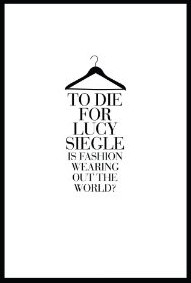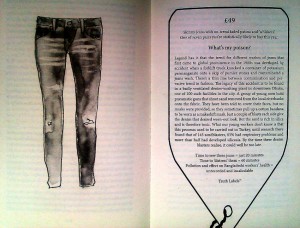 To Die For – Is Fashion Wearing Out the World?
To Die For – Is Fashion Wearing Out the World?
By: Lucy Siegle
ISBN: 9780007264094
320 dense, well researched, and clearly formulated pages, that consolidate for the first time – to my knowledge anyway – much of the insights and data currently available on fashion and consumerism. The reader is not presented with previously entirely unknown, and completely surprising facts, and the strength of the book clearly lies in its thoroughness, and in that it makes the breadth and width of (problematic) issue related to fashion accessible to a broader public.
In fact, there has so far – even if I include books written in German or Italian, for instance – not been A Book that summed it all up so concisely and accessibly. In doing so, the author finds new and convincing arguments to dire realities that have been long known, and nearly as long ignored again, while vividly illustrating the real life context and significance of dry numeric and statistical data. To the degree that virtually every reader, aged ~ 14 years up, will clearly see how the story line relates to his or her own stash of T-shirts, knickers and jeans. Much of this feat is achieved through striking a linguistic balance between research jargon and Friday-after-work-beer-chat on the one hand; and through the author having a go at her very own shopping habits and personal wardrobe and the skeletons hidden therein.
Different to any other ethical fashion or even general sustainability/CSR related book I have read till the very present however, the principle narrative is in 1st person singular throughout. As a consequence, the text is easy to grasp where it matters most: When we readers need to apply what is said in each chapter to our own, personal, and very private fashion footprint.
‘To Die For’ is organised into 15 neatly organised chapters uncovering the ‘bad love’ in our love affair with fashion. The topics tackled in each of the chapters cover the whole geography of fashion consumption:
- The change of consumer habits over the past 20 years, and how this shows in the present in our shopping habits, and – not the least – the ‘look and feel’ of our wardrobe content. [Chapter: Fat Wardrobes and Shrinking Style]
- The how, if not why, of the fast fashion phenomenon and its rock bottom prices [Chapter: Faster and Cheaper]
- Labour conditions of those producing the cheap fast fashion products. [Chapter: Fashion Crimes and Fashion Victims]
- Why third party audits are only as good as the brands’ buying strategies, and the achievements of campaigning [Chapter: Tea, Sympathy, and Auditing]
- The pros and cons of ‘luxury’ on the fashion fashion cycle. Did you know that ‘fast luxury’ is a fact of reality already? [Chapter: In the Lap of Luxury]
- Environmentalism: carbon footprint, energy usage, chemicals used in the various processing stages of fibre and apparel, water footprint and polution. [Chapter: Fashion’s Footprint]
- Why mainstream cotton is just plainly wrong: from subsidies via child labour and pesticides to environmental damage [Chapter: Picking at Cotton]
- Why Kashmir is cheaper than it should be, ‘European wool’ comes from Australia and how traceability can mean ‘buying local’ also in woollens. [Chapter: Woolly Thinking]
- Fashion from animal skin: to Fake or not to fake? And if not to fake, from farmed, wild or ‘food industry by-product’? And why trimmings is just a new word for ‘fast fashion’ on the fur front. [Chapter: Animal Prints]
- Leather is cool. And hypocrite. A look into its environmental and production credentials. [Chapter: Lust for Leather]
- Fashion’s life after the consumer: The story of affordable second-hand clothing in developing countries, environmental hazards in land fills, and how it all gets too much (Chapter: Dumped, Trashed and Burned)
- What you can do, the easy way: asking questions [Chapter: High-Street Thrills and Spills]
- Know the alternatives to mainstream cotton available to you (Chapter: Change Your Knicker Drawer, Save the World?)
- Approaches of buying fashion the better way, without going naked [Chapter: Buying Better Clothes]
- Hands-on tips for managing your wardrobe ‘better’ [Chapter: How Not to Buy]

‘To Die For’ is the book I was looking for a couple of years ago. Maybe it is stretching it a bit, but there is a high chance that this blog, Shirahime, would never have been brought to life had the book existed back then.
The book therefore, scores high in all aspects that someone need to know when seriously interested in the topic, wants to get to know in one single go as much as possible about all the different ‘challenges’ (euphemism!) we find in the fashion supply chain and in fashion consumption.
‘To Die For’ does have its short-comings, although I personally would not necessarily call them just that: If you don’t like information overflow, then this book is probably not for you. It is anything but a light introduction to the topic. And: for as thorough it chucks out the fashion skeletons hidden in the closet and brings them into the bright daylight for everyone to see, there is only a very limited offer in the way of a ‘to this, don’t do the other’ guidelines to do better in the future: You will be required, expected, to show commitment by doing some leg work yourself.
In more general terms, this book leaves the question whether it is better, when writing for a general, while interested, public, to select a few topics and discuss them in as much depth as possible, or alternatively do has the author has chosen to do, bring it all to the table with the most significant and hard to counter arguments at hand.
But, at the bottom line: This book is a very informative read for anyone interested in fashion and/or consumer behaviour, and the aftermaths of their love affair with it. And for those specifically interested in sustainability/ethics in fashion, the book is a compellingly written, well argumented summary of all we always wanted to say, but never find the words to do so.
—
This book is available from your nearest book store as well as online from Amazon.

